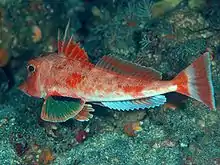Lepidotrigla guentheri
Lepidotrigla guentheri is a species of marine, demersal ray-finned fish from the family Triglidae, the gurnards and sea robins. It is found in the Northwestern Pacific Ocean.[1]
| Lepidotrigla guentheri | |
|---|---|
 | |
| Scientific classification | |
| Domain: | Eukaryota |
| Kingdom: | Animalia |
| Phylum: | Chordata |
| Class: | Actinopterygii |
| Order: | Scorpaeniformes |
| Family: | Triglidae |
| Genus: | Lepidotrigla |
| Species: | L. guentheri |
| Binomial name | |
| Lepidotrigla guentheri Hilgendorf, 1879 | |
Taxonomy
Lepidotrigla guentheri was first formally described in 1879 by the German zoologist and palaeontologist Franz Martin Hilgendorf with the type locality given as Tokyo.[2] The identity off the person honoured in the specific name was not given by Hilgendorf but it is likely to be the ichthyologist and herpetologist Albert Günther of the British Museum (Natural History) who named the genus Lepidotrigla in 1860.[3]
Description
Lepidotrigla guentheri has between 7 and 9 spines, the second being elongated, in the first dorsal fin while both the second dorsal fin and the anal fin have 15 or 16 soft rays. There are 22-24 bucklers, bony plates, along either side of both dorsal fins. There are 14 fin rays in the pectoral fin. There is a projection on the snout which is made up of several spines if varying lengths. There is a large large blackish-blue blotch, with white spots within it, on the lower half of the inner surface of the pectoral fins.[4] The maximum published total length of this species is 20 cm (7.9 in).[1]
Distribution and habitat
Lepidotrigla guentheri is found in the Northwestern Pacific Ocean from Taiwan and the East China Sea north to Korea and Japan.[2] It is a demersal fish found on sandy and muddy substrates along the edge of the continental shelf at depths between 70 and 280 m (230 and 920 ft).[1]
Biology
Lepidotrigla guentheri feeds on the substrate and its diet is dominated by crustaceans particularly Leptochela sydniensis, amphipods, and crabs, as well as small amounts of stomatopods, mysids, cumaceans, krill, polychaetes, and copepods. There is little variation in diet with age but smaller fishes consume a higher proportion of amphipods.[5]
References
- Froese, Rainer; Pauly, Daniel (eds.) (2022). "Lepidotridla guentheri" in FishBase. February 2022 version.
- Eschmeyer, William N.; Fricke, Ron & van der Laan, Richard (eds.). "Species in the genus Lepidotrigla". Catalog of Fishes. California Academy of Sciences. Retrieved 21 June 2022.
- Christopher Scharpf & Kenneth J. Lazara, eds. (19 June 2021). "Order Perciformes (Part 12): Suborder Triglioidei: Families Triglidae and Peristediidae". The ETYFish Project Fish Name Etymology Database. Christopher Scharpf and Kenneth J. Lazara. Retrieved 21 June 2022.
- "Lepidotrigla guentheri". Fishes of Taiwan. Retrieved 21 June 2022.
- Baeck, Gun-Wook; Huh, Sung-Hoi; Choi, Hee-Chan; Park, Jon-Myun (2011). "Feeding Habits of the Redbanded Searobin Lepidotrigla guentheri in the Coastal Waters off Gori, Korea". Korean Journal of Fisheries and Aquatic Sciences (한국수산과학회지). 44 (4): 372–377. doi:10.5657/KFAS.2011.0372.
External links
 Media related to Lepidotrigla guentheri at Wikimedia Commons
Media related to Lepidotrigla guentheri at Wikimedia Commons Data related to Lepidotrigla guentheri at Wikispecies
Data related to Lepidotrigla guentheri at Wikispecies